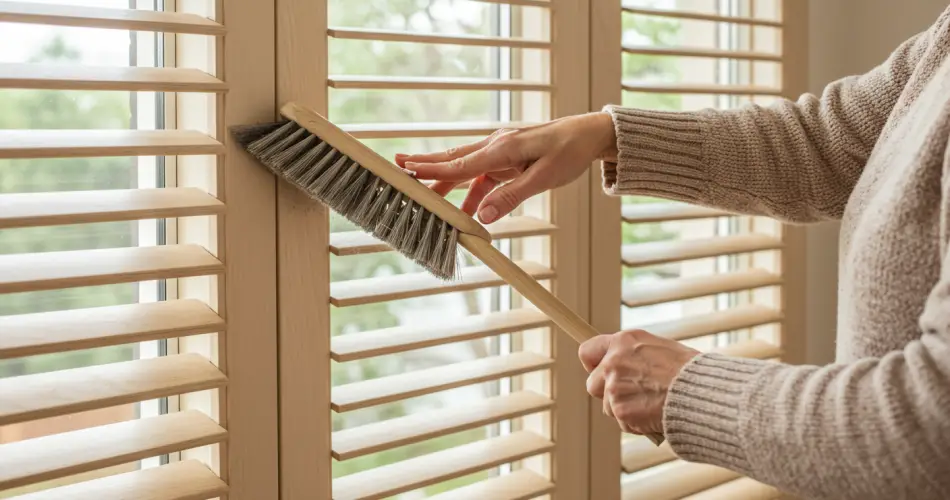House cleaning is a task that requires time, patience, and consistency. Floors, furniture, countertops, and shelves often get most of our attention, but some areas of the home are frequently overlooked—such as shutters and blinds. These surfaces, constantly exposed to the elements and dust, can accumulate dirt quickly, affecting not only the look of your home but also its overall cleanliness.
With the right methods and a few simple ingredients, you can restore shutters and blinds to their original condition, making them look almost brand new. Here’s how.
Why Cleaning Shutters and Blinds Matters
Maintaining a clean home is essential for a healthy living environment, especially when children, pets, or individuals with allergies live in the household. Shutters and blinds, often neglected, are prime spots for dust, grime, and even mold to collect over time.
External shutters face rain, wind, and pollution, while internal blinds gather dust and airborne particles. Without regular cleaning, they not only look unsightly but can also harbor allergens and bacteria.
For households with pets, the problem intensifies. Pet dander easily clings to these surfaces, requiring more frequent maintenance.
First Step: Remove Surface Dust
Before deep cleaning, it’s important to get rid of the loose dirt. Start by using a clean, soft cloth or microfiber duster to wipe both the interior and exterior sides of the shutters or blinds. This first step clears away the bulk of the dirt and makes the washing process more effective.
For blinds that operate with an electric mechanism, don’t forget to check the inside of the casing or housing unit, where dust often collects unnoticed. Since these spaces are difficult to reach with a cloth, use a soft-bristled brush to sweep away the dirt carefully.
This preliminary cleaning step prevents buildup from turning into stubborn stains later.
Washing with Marseille Soap and White Vinegar
Once the surface dirt is gone, it’s time to deep clean. A traditional yet highly effective solution combines two powerful natural cleaners: Marseille soap and white vinegar.
-
Marseille soap is a gentle yet effective degreaser, suitable for removing oily residue and grime.
-
White vinegar is a natural disinfectant that also dissolves grease and leaves surfaces streak-free.
How to prepare and use the solution:
-
Mix warm water with a small amount of grated Marseille soap until it dissolves.
-
Add a splash of white vinegar to the mixture.
-
Dip a microfiber cloth into the solution, wring it out, and gently wipe both sides of the shutters or blinds.
-
Alternatively, pour the solution into a spray bottle and lightly mist the surfaces before wiping with a cloth.
This method works exceptionally well for plastic or metal blinds, leaving them clean and shining. However, extra caution is required when cleaning electric blinds to avoid moisture seeping into sensitive components. Always wring out the cloth thoroughly before wiping and avoid spraying directly onto electrical parts.
Special Care for Wooden Shutters
Wooden shutters require a different approach. While Marseille soap and vinegar are excellent cleaners, they are too harsh for delicate wooden surfaces and may damage the finish.
Instead, use a mild solution made from warm water and a small amount of neutral soap. This mixture gently removes dirt without harming the wood.
Steps for cleaning wooden shutters:
-
Prepare a bucket of warm water with a few drops of neutral soap.
-
Dip a soft cloth into the solution and wring it out well.
-
Wipe each slat carefully, paying attention to corners where dust tends to gather.
-
Dry thoroughly with a clean cloth to prevent moisture damage.
This gentle routine not only cleans but also helps preserve the natural beauty and durability of wood shutters.
Quick Hacks for Dust Removal
Sometimes you don’t have the time for a deep clean, but you still want your shutters and blinds to look presentable. In these cases, everyday household items can come to the rescue.
Old clothing items, such as worn-out socks, wool sweaters, or cotton T-shirts, can be repurposed as dusting tools. Simply slip a sock over your hand and run it along the slats to capture dust quickly. Wool sweaters are particularly good at trapping dust thanks to their texture, making them ideal for a fast cleanup.
This eco-friendly trick not only saves time but also gives new life to clothes that would otherwise be thrown away.
How Often Should You Clean Shutters and Blinds?
-
Weekly: A quick dusting with a cloth, duster, or old sock to prevent buildup.
-
Monthly: A more thorough wipe-down with water and mild soap or vinegar solution.
-
Seasonally: A deep clean, especially after winter and spring, when rain, pollen, and pollution leave more residue on external shutters.
By sticking to this schedule, you’ll keep shutters and blinds in top condition year-round.
Final Tips for Long-Lasting Results
-
Always dry shutters and blinds completely after washing to avoid streaks, watermarks, and mold growth.
-
For electric blinds, avoid excessive water and clean gently to protect the motorized mechanism.
-
Use essential oils (like lavender or lemon) in your cleaning solution for a fresh scent and added antibacterial properties.
-
Don’t wait until dirt becomes visible. Preventive cleaning keeps surfaces looking new and reduces the time you spend scrubbing.
Conclusion
Shutters and blinds are often overlooked during routine cleaning, yet they play a vital role in the overall appearance and hygiene of your home. With natural cleaning solutions like Marseille soap, vinegar, and neutral soap for wood, you can easily remove dirt, restore shine, and prolong their lifespan.
By adopting simple habits—such as dusting weekly, deep cleaning monthly, and using clever hacks like repurposed clothing—you’ll keep your shutters and blinds looking fresh and spotless. It takes only a little effort, but the results will make your home brighter, cleaner, and healthier.



